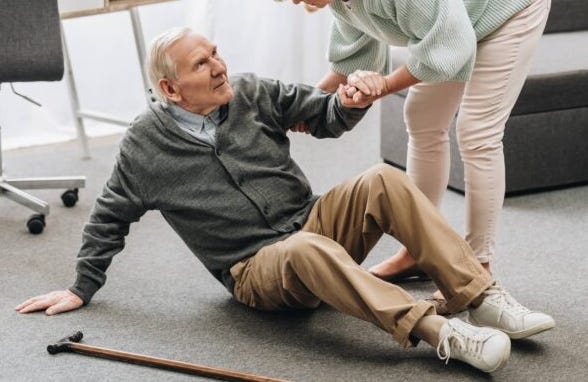The Rise of Falling In Older Adults and How To Reduce Fall Risk
Today’s Topic Highlights:
1 in 4 older adults (14 million) report falling every year.
1 in 5 falls causes a serious injury such as broken bones or head injury.
Falls are the leading cause of both fatal and non-fatal injuries in older adults.
Common risk factors for falling include balance issues, slippery surfaces, cluttered environments, improper footwear, and muscular weakness.
Follow the 4 basic strategies for fall prevention: practice single leg balance exercises, be hyper alert when stepping onto slippery surfaces, keep the walking area of the home free of clutter, and adopt a strength training routine to maintain muscle mass.
“The falls in the elderly are on the rise and taking the shape of an epidemic.” This is a direct quote from a 2020 study published in the Indian Journal of Orthopaedics.1 Given the growing numbers of the aging population and a continuing downward trend in general physical activity, this statement is an eyebrow raiser. Falls in older adults are an issue in serious need of attention.
Between 2014 and 2018 alone, senior falls leading to activity restriction or requiring medical attention rose by 20%, from 7 million to 8.4 million. The number of people annually hospitalized from falls rose from 800,000 to nearly one million during the that same span of time.
According to statistics from the CDC:
1 in 4 older adults (14 million) report falling every year.
1 in 5 falls causes a serious injury such as broken bones or head injury.
At least 300,000 older adults are hospitalized annually for hip fractures.
Falls are the leading cause of both fatal and non-fatal injuries in older adults.
In 2015, medical costs for falls totaled more than $50 billion.
Statistics like these highlight the pressing need for solutions. In order to do something about it though we first must know the battlefield. Understanding risk factors for falling is the first step to strategizing for fall prevention. The key word here is ‘prevention’. Fall prevention must take precedent over fall recovery.
There are many preventable risk factors associated with falls, several of which deserve their own article. These include balance issues, slippery surfaces, cluttered environments, muscular weakness, vitamin D deficiency, poorly lit rooms, improper footwear, and previous fall history to name just a few.
Let’s take the first 4 and quickly review some strategies that can be employed to minimize fall risk.





